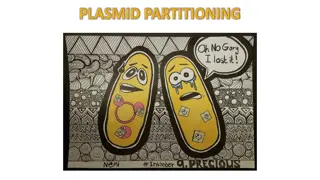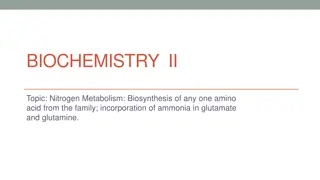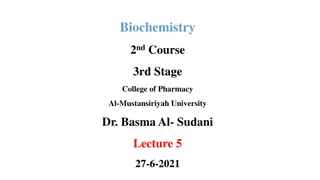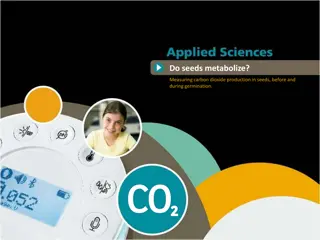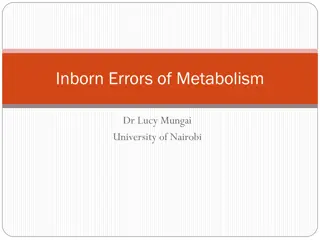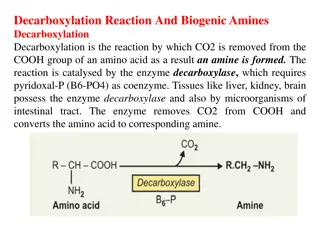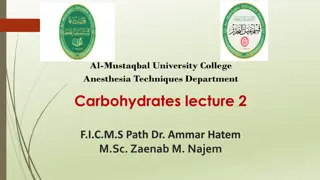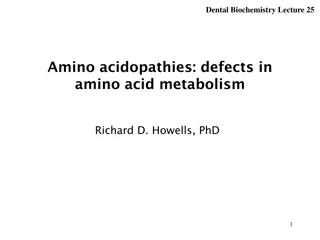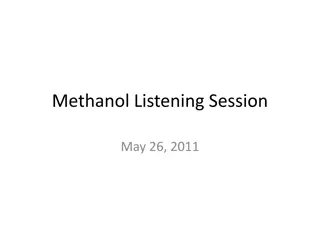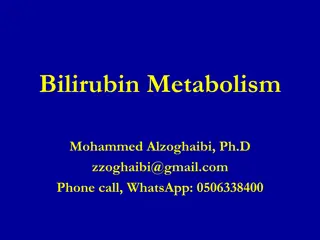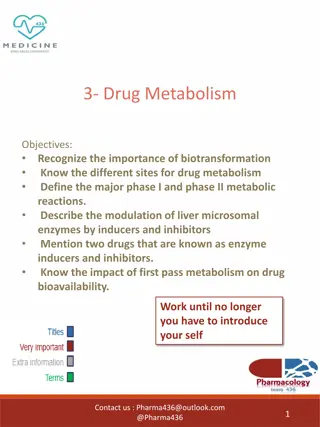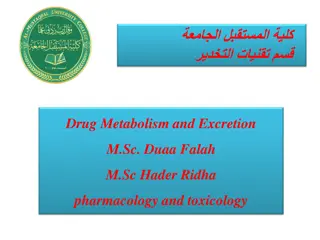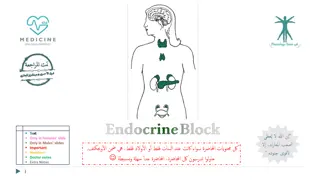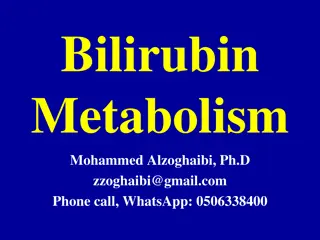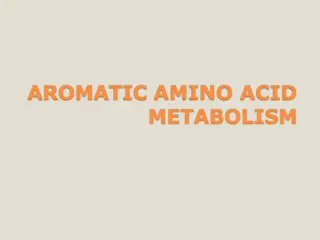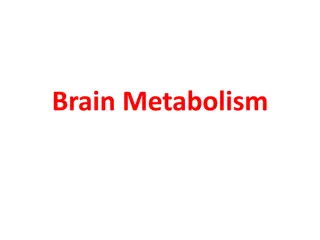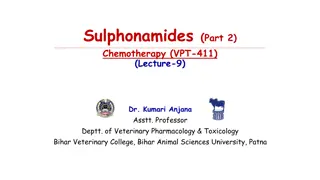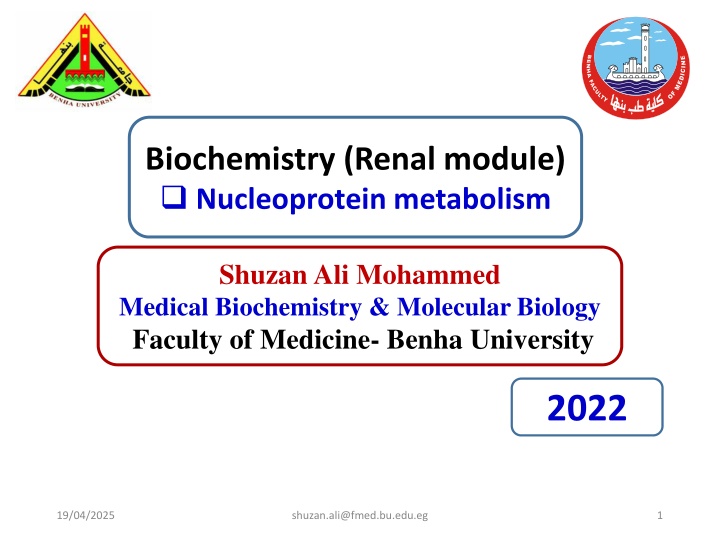
Nucleoprotein Metabolism in Biochemistry
Explore the metabolism of nucleoproteins in the body, from digestion to synthesis of purine nucleotides. Learn about the role of different enzymes and pathways involved in nucleoprotein metabolism for overall cellular function.
Download Presentation

Please find below an Image/Link to download the presentation.
The content on the website is provided AS IS for your information and personal use only. It may not be sold, licensed, or shared on other websites without obtaining consent from the author. If you encounter any issues during the download, it is possible that the publisher has removed the file from their server.
You are allowed to download the files provided on this website for personal or commercial use, subject to the condition that they are used lawfully. All files are the property of their respective owners.
The content on the website is provided AS IS for your information and personal use only. It may not be sold, licensed, or shared on other websites without obtaining consent from the author.
E N D
Presentation Transcript
Biochemistry (Renal module) Nucleoprotein metabolism Shuzan Ali Mohammed Medical Biochemistry & Molecular Biology Faculty of Medicine- Benha University 2022 19/04/2025 shuzan.ali@fmed.bu.edu.eg 1
Nucleoprotein metabolism Diet contains nucleic acids in the form of nucleoproteins Type: nucleoproteins are conjugated proteins [non-protein prosthetic group (nucleic acid) attached to one or more molecules of a simple protein] Simple protein is usually basic protein (histone or protamine) Nucleoproteins are found in all animals & plants ( in all cell nuclei & protoplasm)
Nucleoprotein metabolism In the small intestine mainly & to some extent in the stomach) Nucleoprotein digestion Nucleoproteins Pepsin or trypsin Protein Nucleic acids (DNA & RNA) Pancreatic nucleases Intestinal polypeptidases (protamine & histones) Amino acids Nucleotides Intestinal nucleotidases Phosphate Nucleosides Intestinal nucleosidases Pentose 1-P sugar (ribose 1- P or deoxyribose 1-P) Purines & pyrimidine bases Fate of absorbed nucleic acids: 1.Absorbed purine & pyrimidine: mainly catabolized in the liver 2.Absorbed nucleosides: may be incorporated in the body nucleic acids
Nucleoprotein metabolism Purine metabolism Synthesis of purine nucleotides: Site: they are synthesized by most tissues, however, the major site is the liver (cytoplasm) Pathways: major (De novo) and minor (Salvage) De novo synthesis The purine ring is formed (de novo) in the body from different metabolic intermediates. N.B: Folate is important for formation of C2 & C8 of purine, so antagonists (methotrexate) inhibits purine synthesis and cell division so they are used in treating cancers. folate
Nucleoprotein metabolism Synthesis of nucleoside di- and tri-phosphates: This mechanism is for synthesis of both purine and pyrimidine nucleotide di- and tri-phosphates, which require the corresponding kinase enzyme and ATP.
Nucleoprotein metabolism Synthesis of deoxyribonucleosides: This applies for synthesis of purine & pyrimidine deoxyribonucleotides. The reductase is active only during DNA synthesis enzyme ribonucleotide
Nucleoprotein metabolism Purine salvage pathway Importance: Supply purine nucleotides to certain tissue or cell where the de novo synthesis is not active e.g. brain, red cells and lymphocytes. (APRTase)
Nucleoprotein metabolism *Regulation of biosynthesis of purine nucleotides: 1. Ribose-5-P stimulates PRPP synthetase so R-5-P as in Von Gierke s disease deficiency) leading to de novo synthesis of purines. (glucose-6-phosphatase 2. Normally, more PRPP is used for purine salvage by HGPRTase than for de novo synthesis, so in Lesch-Nyhan syndrome (HGPRTase deficiency) there is in de novo synthesis of purines. 3. High concentration of AMP, ADP, GMP and GDP produce inhibition of conversion of ribose-5-P to IMP at two sites, PRPP synthetase and PRPP-glutamyl amidotransferase.
Nucleoprotein metabolism *Regulation of biosynthesis of purine nucleotides: 4. Regulation of conversion of IMP to ATP and GTP: Both AMP & GMP inhibit their own formation by feedback inhibition of adenylosuccinate synthetase & IMP dehydrogenase, respectively. ATP produces allosteric activation of GMP synthetase that converts XMP to GMP. On the other hand, GTP produces allosteric activation of AS synthetase that converts IMP to AS.
*Regulation of purine nucleotides biosynthesis Nucleoprotein metabolism
Nucleoprotein metabolism Analogue of purine synthesis inhibitors: They act as competitive inhibitors of the naturally occurring nucleotides that are used to synthesize DNA. When wrong bases are incorporated, the DNA becomes functionally inactive. Thereby cell division is arrested. So, they are useful as anticancer drugs. A few examples are: 1. Mercaptopurine inhibits conversion of IMP to GMP & AMP 2. Folate antagonists (methotrexate) would affect the reactions involving one carbon group transfer 3. Azaserine (diazo acetyl-L-serine) is a glutamine antagonist and therefore inhibits reactions involving glutamine. 4. Other synthetic nucleotide analogues used as anticancer agents are 6-thio guanine and 8-aza guanine.
Nucleoprotein metabolism Purine catabolism Uric acid is the end product of purine catabolism in humans. In the tissues: Nucleic acids are hydrolyzed to nucleosides Adenosine is catabolized to hypoxanthine Guanosine is catabolized to xanthine. In the liver: Hypoxanthine gives xanthine by xanthine oxidase which is oxidized to uric acid. Uric acid goes via blood to be excreted by kidneys in urine. In lower animals (not in humans) uric acid is further oxidized to allantoin by uricase enzyme. Serum uric acid level: male: 3-7 mg/dl, female: 2-6 mg/dl Urinary uric acid level: 0.3 0.7 g / d Uric acid is sparingly soluble in water
Nucleoprotein metabolism Purine catabolism IMP AMP GMP Adenosine deaminase (ADA) Phosphomonoesterase Guanosine Inosine Adenosine Adenosine deaminase (ADA) Purine nucleoside phosphorylase (PNP) Guanase Xanthine Hypoxanthine Guanine Xanthine oxidase Xanthine oxidase Allopurinol Uric acid
Nucleoprotein metabolism Gout Definition, causes & characters: Gout is a form of arthritis caused by excess uric acid in the blood stream (hyperuricemia). Urate crystals accumulate in synovial fluid resulting in inflammation leading to acute arthritis. At 30oC, uric acid solubility is lowered, so uric acid is deposited in cooler areas of the body to cause tophi seen in distal joints of foot. Increased excretion of uric acid (uricosuria) may cause deposition of uric acid cystals in the urinary tract leading to calculi or stone formation with renal damage.
Nucleoprotein metabolism Types of Gout: 1ry & 2ry Primary gout: about 1:500 of the total population About 10% of 1ry gout are idiopathic. 1ry gout may show familial incidence Causes of 1ry gout: 1. Abnormal phosphoribosyl amido transferase: The abnormal enzyme is active, but not sensitive to feedback regulation by inhibitory nucleotides purine synthesis 2. Abnormal PRPP synthetase (X-linked recessive): not subject to normal allosteric mechanisms purine synthesis. 3.Deficient purine salavage pathway enzymese.g. HGPRTase deficiency (Lesch-Nyhan syndrome): X-linked; 1:10.000 males. HGPRTase salvage PRPP & inhibitory purines (self mutilation, mental retardation, urate & nephrolithiasis. Gout develops later in life. (i.e. brain is dependent on salvage pathway for IMP & GMP needs).
Nucleoprotein metabolism Causes of 1ry gout (continued): 4.G-6-Pase deficiency (Von Gierke s disease or GSD type I): more glucose enters HMP shunt ribose-5-P PRPP 5.Glutathione reductase variant: this enzyme depends on NADPH from HMP shunt. The abnormality ribose-5-P PRPP. Dysregulation of the rate limiting step of purine nucleotide synthesis synthesis & degradation of uric acid.
Nucleoprotein metabolism Secondary gout: causes 1. production of uric acid: turnover of nucleic acids as in: a) Rapidly growing malignant tissues: leukemia, lymphoma & polycythemia. b) tissue breakdown after treatment of large malignant tumors c) tissue damage by trauma & catabolism (starvation) 2. Reduced excretion rate of uric acid: a) Renal failure b) Treatment with thiazide diuretics (inhibit tubular secretion of uric acid) c) Lactic acidosis and ketoacidosis (interference with tubular secretion)
Nucleoprotein metabolism Treatment policies in gout 1. Reduce the dietary purine intake 2. Increase renal excretion by uricosuric drugs, to decrease urate reabsorption from the renal tubules .e.g. probenecid 3. Reduce urate production by allopurinol, an analogue of hypoxanthine so it is a competitive inhibitor of xanthine oxidase urate formation. Xanthine & hypoxanthine are more soluble & easily excreted. Xanthine oxidase converts allopurinol to alloxanthine. (more effective inhibitor of xanthine oxidase (suicide inhibition) 4. Colchicine; anti-infalammatory very useful to arrest arthritis in gout
Nucleoprotein metabolism Pyrimidine metabolism 2 pathways; de novo & salvage Pathways: major (De novo) and minor (Salvage) De novo synthesis The pyrimidine ring (unlike purine) is synthesized as free pyrimidine, then incorporated into nucleotides. The origin of atoms of pyrimidine nucleus: Carbamoyl phosphate
Nucleoprotein metabolism Steps of De novo Pyrimidine synthesis: 1. Carbamoyl phosphate synthesis: cytoplasmic reaction It is synthesized from nitrogen of glutamine & bicarbonate by carbamoyl phosphate synthetase II (CPS II). 2. Rate limiting step: Carbamoyl phosphate & aspartate combine to form carbamoyl aspartate by aspartyl transcarbamoylase (ATC), allosteric regulated. C2 & N3 are derived from carbamoyl phosphate & the rest from aspartate. 3. Formation of pyrimidine ring: the 3rd nitrogen & the 4th carbon are joined by a covalent bond. Carbamoyl aspartate is cyclized. Dihydro-orotic acid is produced by dihydro orotase (DHOase) 4. Formation of orotic acid by oxidation: hydrogen atoms are removed so that orotic acid is produced by dihydro orotate dehydrogenase (DHODHase). It requires NAD co-enzyme.
Nucleoprotein metabolism Steps of De novo Pyrimidine synthesis (continued): 5. Formation of OMP: Ribose-5-P (from PRPP) is added to orotic acid to form orotidylic acid or orotidine monophosphate (OMP) by orotate phosphoribosyl transferase (OPRT ase) 6. Formation of uridine monophosphate (UMP): by OMP decarboxylase (OMPDC). the enzyme is inhibited by 6-aza- uridine (anticancer). UMP is the 1st purine formed. 7. Synthesis of triphosphates: UMP is phosphorylated to UDP with the help of ATP by nucleoside monophosphate kinase (UMP kinase). UDP is phosphorylated to UTP by nucleoside diphosphate kinase (UDP kinase) with ATP help. 8. Formation of CTP from UTP by CTP synthetase (add amino group from glutamine. It needs ATP)
Steps of De novo Pyrimidine synthesis: Step 1 Step 2 ATC CPS II HCO3- + Glutamine Carbamoyl-P Carbamoyl-Aspartate UMP Step 3 H2O Dihydro-orotase Step 6 OMP decarboxylase Step 5 Step 4 Orotate phospho- ribosyl transfrase DHO dehydrogenase NAD+ NADH+H+ Dihydo-orotate (DHO) Orotate Orotidine monophosphate (OMP)
Steps of De novo Pyrimidine synthesis (continued): Step 7a Step 7b Step 8 Synthetase
Nucleoprotein metabolism Pyrimidine salvage pathway Pyrimidine can also be savaged like purines using PRPP and phosphoribosoyl transferase and nucleoside phosphorylase
Nucleoprotein metabolism Regulation of pyrimidine synthesis: 1. The major regulatory step in prokaryotes is the reaction catalyzed by aspartate transcarbamoylase (ATC) which is allosterically inhibited by CTP. CPS II 2. In the mammalian cells, the regulation occurs at the level of CPS II which is inhibited by UTP and activated Aspartate transcarbamoylase is inhibited by CTP and is activated by ATP. ATC by PRPP. 3. Further, OMP decarboxylase is inhibited by UMP
Nucleoprotein metabolism Synthesis of deoxythymine nucleotides: The thymine nucleotide is formed by thymidylate synthetase by methylation of dUMP. The methyl group is denoted by N5, N10 methylene THFA. Later THFA is regenerated by dihydrofolate reductase using NADPH as the reductant. Thymidylate synthase (Methylene donor)
Nucleoprotein metabolism Anticancer agents acting on pyrimidines: 1. Methotrexate inhibits the enzyme dihydrofolate reductase the regeneration of THFA -- dTMP synthesis -- DNA (methotrexate is a powerful anticancer agent) 2. 5-fluoro-uracil, 5-iodo uracil, 3-deoxy uridine, 6 aza uridine, 6-aza cytidine and 5-iodo-2-deoxyuridine are anticancer drugs, which competitively inhibit thymidylate synthase. Cytosine arabinoside where ribose is replaced by arabinose is another anticancer agent.
Nucleoprotein metabolism Orotic aciduria It results from absence of one or both enzymes; OPRT ase and OMP decarboxylase orotic acid production excretion of urine It is autosomal recessive, with retarded growth & megaloblastic anemia. The rapidly growing cells are more affected (anemia). Crystals are excreted in urine which may cause urinary tract obstruction. Due to lack of feedback inhibition, orotic acid production is excessive It can be successfully treated by feeding cytidine or uridine. They may be converted to UTP which can act as feedback inhibitor Orotic aciduria may also occur in ornithine transcarbamoylase deficiency (urea cycle enzyme) as carbamoyl phosphate accumulates due to defective conversion to citrulline. Allopurinol compete with orotic acid for the enzyme orotate phosphoribosoyl transferase, leading to orotic aciduria & orotidinuria.
Nucleoprotein metabolism Catabolism of pyrimidine nucleotides: Uracil & thymine are degraded by analogous reactions. The phosphate is removed from nucleotide corresponding nucleoside In the next step, free base is released, the ring is open Finally, amino isobutyric acid or alanine are formed. These are the end product of pyrimidines. Other products are carbon dioxide and ammonia. Pseudouridine is not metabolized further, and is excreted as such in urine. Cytosine Thymine Uracil CO-ASH Methylmalonyl CoA Succinyl CoA


